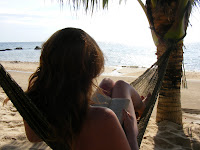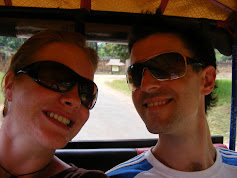
As you can probably tell by the frequency of Marie's posts, Marie has been using the wifi in our room in Bangkok to write blog posts. I used this time to watch the Bourne Ultimatum & Ultraviolet. Bourne Ultimatum is a good movie, if you like that kind of thing, and Ultraviolet is pure B grade ridiculousness. Anyway, I think the last post I had written was up to our arrival in Cambodia, in the capital Phnom Penh. Our time in Cambodia was severely abbreviated from the original plan due to us spending more time in Vietnam than anticipated. Thus we only had 3 nights in Phnom Penh and 4 nights in Siem Reap, which is truncated in comparison to our 4 weeks in Vietnam.
Point of preceding paragraph: Despite only spending 3 nights in Phnom Penh, I really liked this city and would consider moving here if I could find a job to keep me (and my betrothed) in the lifestyle to which I have become accustomed. At this point a job as an research economist with a particular focus on Cambodian economic development (and resultant need to spend a lot of time in Cambodia) is looking really attractive.
The most surprising thing about my receptivity toward Phnom Penh was that we spent one of our two full days here going to the Killing Fields and the S-21 museum at the site of the main detention centre. If anything should turn me off a place it would be these two locations. For more detail please see below the fold. Warning: disturbing content to follow.
The Killing Fields just south of Phnom Penh was the main execution site for the Pol Pot regime, where an estimated 20,000 people were killed and buried in a series of mass graves during the senseless purges of the 1970s. People were rounded up and killed for infractions as minor as wearing glasses or previously holding any kind of highly skilled job, on the grounds that such people were not the correct calibre of people to carry out the revolution and accompanying reversion to an agrarian society. Our guide explained that anyone identified as a doctor, lawyer or other 'intellectual' was rounded up and killed. The killers first used bullets to execute their victims, but then realised that bullets were too expensive so resorted to methods such as:
a) tying a group of people together, pushing them into water and then shooting one so the others were pulled down and drowned;
b) in the case of young children or babies, swinging the children against a tree until dead or throwing them up into the air and catching them on bayonets; or
c) using a length of palm frond as a machete, from a species of palm tree which has a series of sharp thorns along the frond.
As we walked along the paths between the mass graves we stepped over clothing and bones which had been exposed by the elements. And I am not talking about isolated fragments, these were strewn everywhere. The overall effect was completely and utterly shocking, and yet at the same time it was a very tranquil space. No photos to be posted.
After the Killing Fields we went to the S-21 museum, which is on the site of the regime's former head interrogation centre and prison. As a macabre touch, this site was a school before its conversion. The most moving exhibit here was a series of rooms, which simply showed the photos taken of the people bought here for interrogation before being sent on to the Killing Fields. The easiest western equivalent I can think of here is of a booking photo which is taken when someone is arrested. There was room after room of photos, with the total number of photos probably upward of three thousand. The thing which really affected me was when I started to look into the victims' eyes. Only a few of the victims showed any fear- the most common expression was a sense almost of resignation at their fate. As with the Killing Fields, I can't understand why this slaughter occurred.
As you can guess, the combination of these two memorials was a complete emotional wipeout. Despite this I think these sites are a must see.
The next day we went on a Khmer cooking course to cheer ourselves up. If you have been keeping score, you will realise that this makes cooking courses in all four countries on our trip. If Napoleon said that an army marches on a full stomach, my paraphrase would be that I like to travel on a full stomach. The highlight of the Khmer course for me was making Fish Amok. This is a mild fish curry, steamed rather than fried, which is steamed within a banana leaf shell. Khmer food in general is not particularly spicy, as the Khmer cooking heritage predates the introduction of the chili by the Portuguese in the 16th century. Another interesting recipe was sausage with pork and chicken mince, wrapped up within a banana flower prior to deep frying.


After a full day of cooking and eating neither of us were particularly hungry, so we went to a rooftop bar looking out over the river for a relaxing drink & people-watch. This is the scene for the photo at the top of the post (when blogger behaves itself). From our perch we saw six people travelling on one scooter!
I should explain that from Hanoi onward Marie and I have been trying to spot as many people as possible on a scooter. Three was common in Vietnam, and four was rare. She saw five in Ho Chi Minh city, and I saw four on a bicycle in the Mekong Delta. Cambodia blew Vietnam out of the water for scooter passenger density. In Cambodia four was common, and five was rare.
Also, the variety of cargo which is transported by scooter has to be seen to be believed. We have seen people with large fridges strapped to the back of their scooters, and a passenger holding a full size door upright between the driver and himself.























